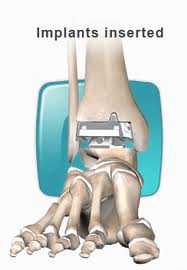Ankle replacement is surgery to replace the damaged parts of the three bones that make up the ankle joint. Artificial joint parts (prosthetics) are used to replace your own bones. They come in different sizes to fit different-size people.
Description
 Ankle replacement surgery may be done while you are under general anesthesia. This means you will be asleep and pain-free. Or, you may have spinal anesthesia. You will be awake but will not feel anything below your waist. If you have spinal anesthesia, you will also be given medicine to help you relax during the operation.
Ankle replacement surgery may be done while you are under general anesthesia. This means you will be asleep and pain-free. Or, you may have spinal anesthesia. You will be awake but will not feel anything below your waist. If you have spinal anesthesia, you will also be given medicine to help you relax during the operation.
Your surgeon will make a surgical cut in the front of your ankle to expose the ankle joint. Your surgeon will then gently push the tendons, nerves, and blood vessels to the side. After this:
- Your  surgeon will remove the damaged bone.
- Your surgeon will reshape three of your bones that will remain in place:
- The lower end of your shin bone (tibia)
- The lower end of your smaller lower leg bone (fibula)
- The top of your foot bone (talus) that the leg bones rest on
- The parts of the new artificial joint are then attached to the cut bony surfaces. A special glue/bone cement may be used to hold them in place. Often, screws are also placed through the two leg bones (fibula and tibia) to help support the artificial ankle.
- A bone  graft is created between the ends of the fibula and tibia. This makes your  new ankle more stable.
After putting the tendons back into place, the surgeon closes the wound with sutures (stitches). You may need to wear a brace for a while to keep the ankle from moving.
Why the Procedure is Performed
Ankle replacement surgery may be done if the ankle joint is severely damaged. Your symptoms may be pain and loss of movement of the ankle. Some causes of damage are:
- Arthritis caused by ankle surgery in the past
- Bone fracture
- Infection
- Osteoarthritis
- Rheumatoid arthritis
Risks
Risks for any anesthesia are:
- Allergic reactions to medicines
- Breathing problems
Risks for any surgery are:
- Bleeding
- Blood clot
- Infection
Risks for ankle replacement surgery are:
- Allergic reaction to the artificial joint
- Ankle weakness, stiffness, or instability
- Blood vessel damage
- Bone break during surgery
- Dislocation of the artificial joint
- Loosening of the artificial joint over time
- Nerve damage
- Skin not healing after surgery
Before the Procedure
Always tell your doctor or nurse what drugs you are taking, even drugs, supplements, or herbs you bought without a prescription.
During the 2 weeks before your surgery:
- You may be asked to stop taking drugs that make it harder for your blood to clot. These include aspirin, ibuprofen (Advil, Motrin), naproxen (Naprosyn, Aleve), and other drugs.
- Ask your doctor which drugs you should still take on the day of your surgery.
- If you have diabetes, heart disease, or other medical conditions, your surgeon will ask you to see your doctor who treats you for these conditions.
- Tell your doctor if you have been drinking a lot of alcohol, more than one or two drinks a day.
- If you smoke, try to stop. Ask your doctor or nurse for help. Smoking can slow down wound and bone healing.
- Always let your doctor know about any cold, flu, fever, herpes breakout, or other illness you may have before your surgery.
- You may want to visit the physical therapist to learn some exercises to do before surgery. The physical therapist can also teach you how to correctly use crutches.
On the day of your surgery:
- You will usually be asked not to drink or eat anything for 6 to 12 hours before the procedure.
- Take the drugs your doctor told you to take with a small sip of water.
Your doctor or nurse will tell you when to arrive at the hospital.
After the Procedure
After surgery, you will need to stay in the hospital for 3 to 4 days.
Your ankle will be in a cast or a splint after surgery. A small tube that helps drain blood from the ankle joint may be left in your ankle for 1 or 2 days. To keep swelling down, keep your foot raised higher than your heart while you are sleeping or resting.
Your doctor may recommend physical therapy to teach you exercises that will help you move more easily.
Outlook (Prognosis)
A successful ankle replacement will get rid of your pain and allow you to move your ankle up and down. Usually, total ankle replacements last 10 or more years. How long yours lasts will depend on your activity level, overall health, and the amount of damage to your ankle joint before surgery.
Alternative Names
Ankle arthroplasty – total; Total ankle arthroplasty; Endoprosthetic ankle replacement; Ankle surgery


